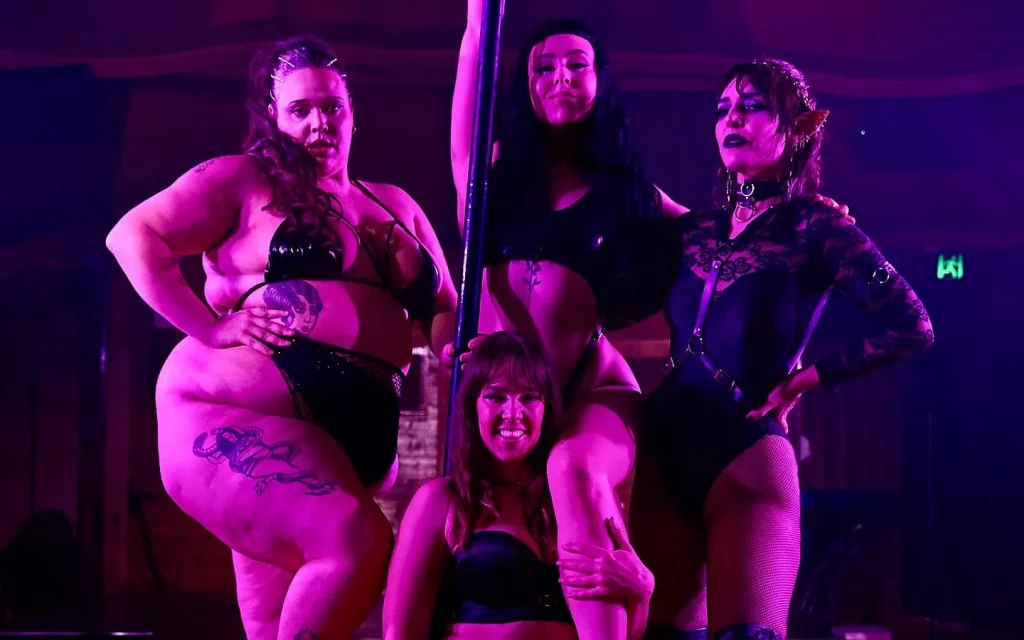Heralded by hymn music, ‘Pole Dance Daddy’ Cleo Rapture strutted into the middle of the big top wearing a shiny robe and eight-inch platforms. If the nightclub is a queer church, then Rapture is like a lesbian Jesus, frequently appearing on LGBTQIA+ dance floors like Heaps Gay, Dykadellic and Junipero. At the 2024 Sydney Fringe Festival, Rapture transformed a smoke-filled tent into a site of communion.
Now in its third year, The Rapture is a strip circus variety show that celebrates the divinity of the queer body. Rapture is joined by Miss Peaches, Marlena Dalí and Mama Medusa, with acts ranging from the flying pole to playing with fire. The night began with offerings of holy wafers and ended with audience confessions (punctuated by a slutdrop). But it was also a communion in the emotional sense, as Rapture took the stage to share what life is like as a queer stripper and ‘Italian wog’ from regional NSW.
Rapture’s doubles pole routine with Miss Peaches was a standout, platforming queer joy and dancing for dancing’s sake. But even this kind of dance is a privilege. Rapture created a dissonance between The Rapture’s glittering, transcendent performances and the stories she told in between about hustling during a cost-of-living crisis. We are not allowed to ignore the person behind the performer.
Even the show’s unpolished moments (stumbles in reading from notes, the somewhat rushed pacing) were a reminder that art – its beauty, escapism and ability to bring hope – is built by tireless human hands. The Rapture was a space of reclamation, where the performers shared themselves on their own terms. This message sat uncomfortably with the presence of an audience – for this space, too, was part of the hustle.
Even so, baring all, both physically and spiritually, is an act of tremendous generosity. Sex work is a stigmatised industry, only decriminalised in Queensland earlier this year. Meanwhile, pole dancing classes have exploded in popularity in the last decade. Many studios profit from the glamour of the dance form without understanding – and sometimes contributing to – the discrimination and unsafe conditions faced by sex workers.
Each performer in The Rapture was multitalented, gritty and committed to community. Community, in particular, has always been lifesaving for queer people and is key for marginalised creators to stay afloat in Sydney’s under-funded alternative arts scene.
Miss Peaches is an instructor at Duality Pole, one of the studios that filled the void after the closure of Sky Sirens, a pioneering sex worker-led studio that walked the talk on inclusivity.
Non-binary drag prince and make-up artist extraordinaire Marlena Dalí, in elf ears and a chain-link bikini, was a celestial presence – and this was before they started swallowing fire. Now based in Newcastle, Dalí has hosted many a cabaret, the stages of which have helped hordes of up-and-coming drag performers find their freak.
Draglesque siren Mama Medusa entered the stage voice-first, drowning the audience with her powerful vocals before breaking into dance. The fat sexuality champion and former Sky Sirens instructor continues to teach burlesque and organise performances out of the Imperial Basement.
Miss Peaches and Mama Medusa’s entrances were well timed, while there was a missed opportunity to incorporate more of Dalí’s story into the show’s narrative arc.
So why The Rapture as a title? In an industry that’s all about giving others pleasure, Cleo Rapture has survived by wresting small moments of rapture for herself out of every day.
She told us: “If you aren’t in the golden shower, perhaps you are the golden shower.”
The Rapture was a call to pleasure, with plenty of audience participation to boot. It will be exciting to see where The Rapture takes us next.
The Rapture was performed from 24 to 29 September at Village Green Festival Garden as part of the Sydney Fringe Festival.
First published by ArtsHub on October 10, 2024. This article has been commissioned in partnership with Artshub for Diversity Arts Australia’s StoryCasters project, supported by Multicultural NSW, Creative Australia and Create NSW.

